
Belchertown is a town in Hampshire County, Massachusetts, United States. It is part of the Springfield, Massachusetts Metropolitan Statistical Area. The population was 15,350 at the 2020 census. The town includes the census-designated place of Belchertown. Belchertown was formerly the home of the Belchertown State School. The land on which the school sat is, as of 2016, being redeveloped for mixed uses including residential, commercial and recreational. This includes the 385-acre (156 ha) Lampson Brook Farm, used for community and sustainable agriculture, outdoor recreation, and wildlife preservation.
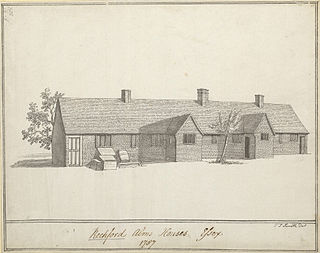
An almshouse is charitable housing provided to people in a particular community, especially during the Middle Ages. They were often targeted at the poor of a locality, at those from certain forms of previous employment, or their widows, and at elderly people who could no longer pay rent, and are generally maintained by a charity or the trustees of a bequest. Almshouses were originally formed as extensions of the church system and were later adapted by local officials and authorities.

Willowbrook State School was a state-supported institution for children with intellectual disabilities located in the Willowbrook neighborhood on Staten Island in New York City from 1947 until 1987.

The Walter E. Fernald State School, later the Walter E. Fernald Developmental Center, was the Western hemisphere's oldest publicly funded institution serving people with developmental disabilities. Originally a Victorian sanatorium, it became a "poster child" for the American eugenics movement during the 1920s. It later was the scene of medical experiments in the 20th century. Investigations into this research led to new regulations regarding human research in children.
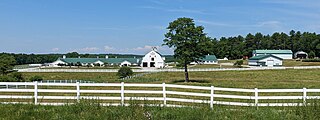
Pineland Farms is a 5,000-acre farm and recreational property in the eastern part of New Gloucester, Maine. It is partly on the site of the former Pineland Hospital and Training Center.
Self-advocacy is the act of speaking up for oneself and one's interests. It is used as a name for civil rights movements and mutual aid networks for people with intellectual and developmental disabilities. The term arose in the broader civil rights movements of the 1960s and 1970s, and is part of the disability rights movement. Today there are self-advocacy organizations across the world.
Ruth Sienkiewicz-Mercer was a quadriplegic and American disability rights activist. She is best known for her autobiography I Raise My Eyes to Say Yes, co-authored with Steven B. Kaplan.
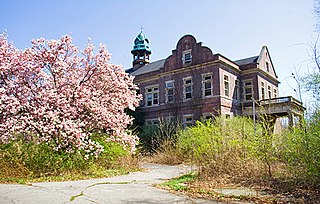
Pennhurst State School and Hospital, originally known as the Eastern Pennsylvania State Institution for the Feeble-Minded and Epileptic was a state-run institution for mentally and physically disabled individuals of Southeastern Pennsylvania located in Spring City. After 79 years of controversy, it closed on December 9, 1987.

The Rosewood Center was an institution for people with developmental disabilities located on Rosewood Lane in Owings Mills, Maryland.
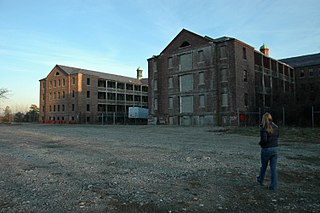
Northampton State Hospital was a historic psychiatric hospital at 1 Prince Street on top of Hospital Hill outside of Northampton, Massachusetts. The hospital building was constructed in 1856. It operated until 1993, and the building was added to the National Register of Historic Places in 1994.

The Monson Developmental Center was a Massachusetts state facility in Monson, Massachusetts. The property, whose core has been in state control since 1854, historically housed a variety of facilities for providing services to the indigent or sick. It was closed in 2012, and the state is soliciting bids for sale and reuse of the developed portions of the property.
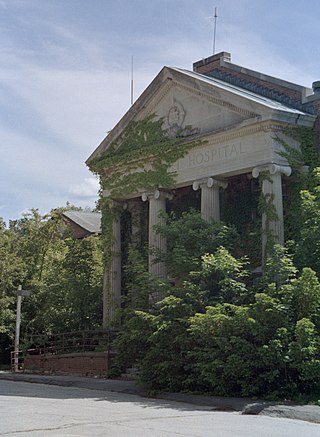
The Mansfield Training School and Hospital was a state school for people with developmental disabilities located in Mansfield, Connecticut, United States. It was active from 1860 to 1993. Its former campus, located at the junction of Connecticut Route 32 and United States Route 44 in Mansfield is a 350-acre (140 ha) historic district that was listed on the National Register of Historic Places in 1987.

The Fairview Training Center was a state-run facility for people with developmental disabilities in Salem, Oregon, United States. Fairview was established in 1907 as the State Institution for the Feeble-Minded. The hospital opened on December 1, 1908, with 39 patients transferred from the Oregon State Hospital for the Insane. Before its closure in 2000, Fairview was administered by the Oregon Department of Human Services (DHS). DHS continued to operate the Eastern Oregon State Hospital in Pendleton until October 31, 2009.

Letchworth Village was a residential institution located in Rockland County, New York, in the hamlet of Thiells built for the physically and mentally disabled of all ages, from the newborn to the elderly. Opened in 1911, Letchworth Village at its peak consisted of over 130 buildings spread out over many acres of land. It was named for William Pryor Letchworth, who espoused reform in the treatment and care of the insane, epileptics, and poor children.

The Virginia State Colony for the Epileptics and Feeble Minded was a state run institution for those considered to be “Feeble minded” or those with severe mental impairment. The colony opened in 1910 near Lynchburg, Virginia, in Madison Heights with the goal of isolating those with mental disabilities and other qualities deemed unfit for reproduction away from society. The colony was the home of Carrie Buck, the subject of the landmark Supreme Court case Buck v. Bell.
The Ladd School in Exeter, Rhode Island operated from 1908 to 1993 as a state institution to serve the needs of people with mental disabilities or developmental delays. It was closed largely due to the deinstitutionalization movement of the 1980s.
Wayne County Training School, alternately known as the Wayne County Training School for Feeble Minded Children or the Wayne County Child Development Center, was a state-funded institution for people with developmental disabilities, located in Northville Township, Michigan. Construction of the institution began in 1923, and it opened in 1926. Expansion on the property continued until 1930. The school closed its doors on October 18, 1974. Most of the buildings were left abandoned until 1998, when the land was sold and the abandoned institution was demolished after that.
William D. Partlow Developmental Center, also known as the Partlow State School and Hospital, was a state school for people with mental disabilities, primarily intellectual and developmental disabilities in Tuscaloosa, Alabama, USA. It was operated by the Alabama Department of Mental Health. It was the last such full-sized facility operated by the State of Alabama and closed in 2011.
State schools are a type of institution for people with intellectual and developmental disabilities in the United States. These institutions are run by individual states. These state schools were and are famous for abuse and neglect. In many states, the residents were involuntary sterilized during the eugenics era. Many states have closed state schools as part of the deinstitutionalisation movement.


















